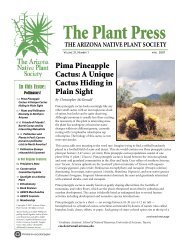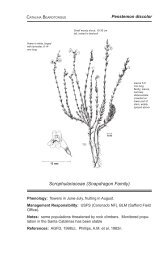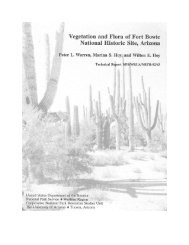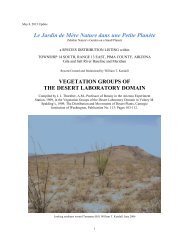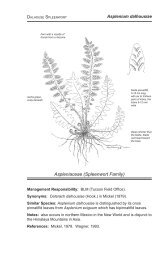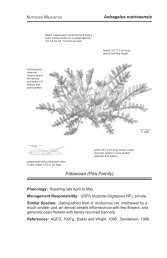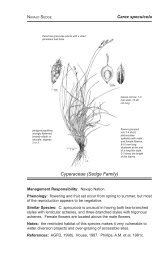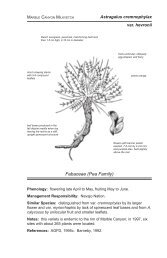T14S.R13E Pima County.AZ 050813 - Arizona Native Plant Society
T14S.R13E Pima County.AZ 050813 - Arizona Native Plant Society
T14S.R13E Pima County.AZ 050813 - Arizona Native Plant Society
You also want an ePaper? Increase the reach of your titles
YUMPU automatically turns print PDFs into web optimized ePapers that Google loves.
COMMON NAMES: Wright Lipfern; Wright’s Lip Fern; Wright’s Lipfern. DESCRIPTION: Terrestrial perennialevergreen forb/herb (fronds are 1½ to 10 inches in length); the leaf blades are green with brown to dark brown stipes; sporulationgenerally takes place between summer and fall. HABITAT: Within the range of this species it has been reported frommountains; rocky mountainsides; mesas; rock cliffs; bases of cliffs; rocky canyons; rocky canyon walls; bouldery and rockycanyon bottoms; chasms; talus slopes; soil filled crevices in rocks; rocky ledges; rocky ridges; ridgetops; foothills; rocky hills;hilltops; bouldery and rocky hillsides; along bouldery, rocky and rocky-gravelly-clayey slopes; bouldery and rocky outcrops;amongst rocks; on boulders; bases of boulders and rocks; rocky nooks; shady and mossy banks; within bedrock and rockyarroyos; draws; rocky ravines; along streams; streambeds; within rocky washes; rocky-gravelly drainages; soil pockets indepressions; rocky shelves; bottomlands, and rocky riparian areas growing in moist and dry bouldery, rocky, rocky-gravelly andgravelly ground; gravelly-sandy loam and sandy-clayey loam ground, and rocky-gravelly clay and gravelly clay ground,occurring from 900 to 7,100 feet in elevation in the forest, woodland, scrub, grassland, desertscrub and wetland ecologicalformations. NOTES: This plant may be an attractive component of a restored native habitat. Cheilanthes wrightii is native tosouthwest-central and southern North America. *5, 6, 15, 16, 43 (081109), 44 (031911 - no record of species; genus record), 46(Page 40), 51 (Page 141, color photograph 144), 58, 63 (081109 - color presentation), 77, 85 (083011 - color presentation ofdried material), 89 (reported as being a perrenial herb located on Tumamoc Hill), 122, 124 (031911 - no record of species; genusrecord), 140 (Page 303)*Notholaena cochisensis (see Astrolepis cochisensis subsp. cochisensis)Notholaena hookeri (see footnote 89 under Notholaena standleyi)Notholaena sinuata (see footnote 89 under Astrolepis cochisensis subsp. cochisensis)Notholaena sinuata var. cochisensis (see Astrolepis cochisensis subsp. cochisensis)Notholaena standleyi W.R. Maxon: Star Cloak FernSYNONYMY: Cheilanthes standleyi (W.R. Maxon) J.T. Mickel. COMMON NAMES: Cloak Fern (a name alsoapplied to the genus Notholaena); [Star] Cloak Fern (English) 140 ; Cloak-fern; Hehe Quina (“Hairy <strong>Plant</strong>”, Seri) 140 ; Helecho(“Fern”, Spanish) 140 ; Rock Fern (English) 140 ; Standley Cloak Fern; Standley’s Cloak Fern; Star Cloak Fern; Star Cloak-fern; StarCloakfern. DESCRIPTION: Terrestrial perennial evergreen forb/herb (fronds are 2 to 13 inches in length with the star-shapedlaminae being 1 to 4 inches in width; one clump was observed and described as being up to 8 inches in width); the leaf blades area shiny dark green above (with a cream-white, gold, silvery-yellow, yellow or yellow-green waxy-looking glandular exudatebelow) with brown or reddish-brown stipes; sporulation generally takes place between late spring and fall. HABITAT: Withinthe range of this species it has been reported from mountains; rocky mountaintops; rocky mountainsides; rocky cliffs; along basesof cliffs; bouldery and rocky canyons; canyon walls; bouldery canyon bottoms; rocky gorges; along crevices in rimrock, bouldersand rocks; buttes; bouldery-gravelly knobs; rocky knolls; rocky and sandy ledges; under rocky ledges; rocky ridges; foothills;hills; rocky hilltops; bouldery and rocky hillsides; bouldery, bouldery-gravelly, rocky, rocky-gravelly-clayey, rocky-sandyclayey-loamy,rocky-loamy-silty, sandy-loamy and loamy slopes; bajadas; boulder and rocky outcrops; amongst boulders, brokenrocks and rocks; bases of boulders and rocks; hidden beneath overhanging rocks; sandy lava flows; bouldery lava beds; shadedpockets; bouldery prairies; along rocky arroyos; within rocky draws; gulches; rocky ravines; creekbeds; in bouldery-sandy andsandy washes; drainages; rocky banks of washes, and riparian areas growing in dry rimrock; bouldery, bouldery-gravelly,bouldery-sandy, rocky and sandy ground; rocky-sandy-clayey loam, gravelly loam, sandy loam, silty loam and loam ground;rocky-gravelly clay ground, and rocky-loamy silty ground, occurring from 900 to 8,000 feet in elevation in the woodland, scrub,grassland, desertscrub and wetland ecological formations. NOTES: This plant may be an attractive component of a restorednative habitat, it is commonly found growing in clumps. Notholaena standleyi is native to southwest-central and southern NorthAmerica. *5, 6, 15, 16, 28 (color photograph 11), 43 (081109), 44 (031911 - no record of species; genus record), 46 (Page 42),51 (Page 157, color photograph 174), 58, 63 (081109 - color presentation), 85 (083011 - color presentation), 89 (reported asbeing a perrenial herb located on Tumamoc Hill, recorded as Notholaena hookeri D.C. Eaton,), 115 (color presentation), 124(031911), 140 (Pages 229, 231-232 &303)*Pellaea longimucronata (see Pellaea truncata)Pellaea truncata L.N. Goodding: Spiny CliffbrakeSYNONYMY: Pellaea longimucronata auct. non W.J. Hooker. COMMON NAMES: Calaguala (Spanish: Mexico) 140 ;Cliff Brake (a name that is also applied to the genus Pellaea); Cliff-brake Fern (a name also applied to the genus Pellaea); SpinyCliff Brake (English) 140 ; Spiny Cliff-brake; Spiny Cliffbrake. DESCRIPTION: Terrestrial perennial evergreen forb/herb(ascending fronds are 3 to 16½ inches in length); the leaf blades are blue-green or gray-green with chestnut-brown, reddish orred-brown stipes; sporulation generally takes place from late spring to fall. HABITAT: Within the range of this species it hasbeen reported from mountains; crags; mountainsides; rocky cliffs; cliff walls; niches and crevices in rock cliffs; along bases ofcliffs; bouldery and rocky canyons; along canyon walls; along rocky canyon bottoms; rocky gorges; talus slopes; crevices inboulders and rocks; pockets of sandy soil in boulders; rocky bluffs; rock ledges; under rocky ledges; ridgelines; foothills; rockyhills; bouldery-rocky and rocky hillsides; bouldery, bouldery-rocky, bouldery-gravelly, rocky, gravelly, gravelly-loamy, sandy,16



